Beans are delicious when eaten raw, cooked, hot, or cold, and especially when picked and eaten fresh from the plant growing in your own back yard! Beans are a wonderful plant to grow in your vegetable patch or even in containers on your back porch.
These different bean varieties grow well when planted together, either directly into the ground or in plant containers and placed in full sun.
- Fava beans
- Great Northern Beans
- Lima Beans
- Navy beans
- Pinto beans
- Kidney beans
- Green beans
- Porch pick beans
- Royal burgundy beans
Beans are sturdy, low-maintenance plants that thrive during the warm season. Each bean plant can produce a wonderful crop of pods and beans, which are used around the world in different dishes. They have fantastic health benefits as they are packed with protein and are rich in antioxidants. They make great companion plants when planted with other beans.
What Are The Different Varieties Of Beans?
Beans have been grown for centuries to be used as food for humans and animals. Around the world, they are known by many different names, but all have the same characteristics: snap beans, shell beans, or dry beans.
- Snap beans. The typical green pod bean which can be eaten whole.
- Shell beans. The individual beans grow in a pod which is removed to be eaten.
- Dry beans. These beans are left in the pod to mature and only removed when they are hard and dry.
Although beans are known by many different common names, there are only two different varieties of beans:
Pole Beans
These are tall growing vine beans that require support to prevent them from toppling over. Pole beans are the perfect bean to grow in vertical spaces and can be trained to grown-up trellis fences either in containers or in small areas in your back yard.
Pole beans take longer to mature than bush beans. Pole beans are indeterminate, which means that when they do start producing, they will produce new beans for the entire season, providing you with an abundance of beans for many months!
Planted along a fence or even growing up the side of a garden shed, pole beans provide a colorful backdrop to any other vegetables or flowers which are growing in the same bed without using up too much space.
Runner beans are from the pole bean variety, but they prefer cooler conditions.
Bush Beans
This bean variety is a ground-growing bean that will flourish anywhere that it is planted. Bush beans grow more quickly than pole beans which means that you can harvest a bean crop sooner.
As bush beans are determinate, most of the crop will be produced during one harvest, and the plant will not produce any more new beans. If they were planted early in the season, you might get a second crop before the plant goes into decline. After the bean crop has been harvested, the plant will eventually decline and should be replaced.
Bush beans do not spread very much, so you can plant a few plants together in a large bed or even in a large container.
9 Beans That Will Grow Well Together
Beans come in all different shapes, colors, and sizes. They are grown as food but make a colorful, eye-catching display when planted alongside different types of beans or even alongside different plants in your garden.
Here are our favorite beans from both the pole and bush varieties, which will grow well together in any garden patch or container. By comparing the planting, growing, and harvesting requirements, you should be able to decide which bean plants you can grow together and whether to plant them in the ground or in a container.
Follow the list of instructions further down in this post on how to plant beans and what the requirements are for each variety.
1. Fava Beans (Pole)
Fava beans, commonly known as broad beans, are an annual vegetable, usually planted in early spring or fall. Their edible seeds, which grow inside a pod, come in a variety of colors, black, beige, brown, purple, and white, and grow to different sizes.
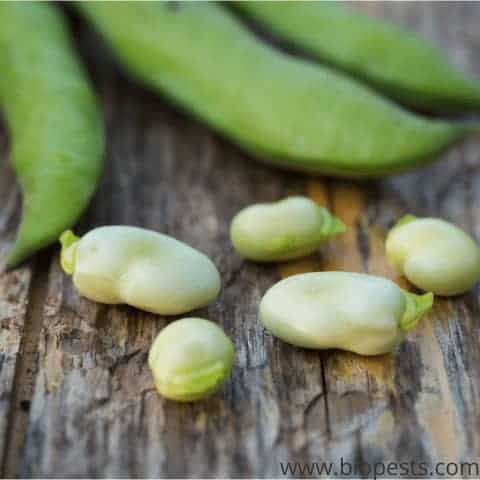
Fresh fava beans can be eaten cooked or raw or dried for later use. They are mostly used in stews, salads, and sauces but can be used as fillings or eaten as a snack. After harvesting, the beans can be cooked while still in the pods or frozen for later use. Cooked beans can be dried out in the refrigerator or used as a puree.
- Fava beans require a growing season of 75 – 90 days.
- The beans can be harvested when the pods feel full.
- They grow well in full sun or partial shade and require about 1 inch of water per week.
- They are easy to grow, and each plant produces a colorful flower.
- In mild climates, they can be planted in the fall to grow throughout winter for a spring harvest.
- Large and leafy, the plants can reach up to 7 feet tall, making them ideal for growing along a fence or trellis.
2. Great Northern Beans (Bush)
The great northern bean is a small white bean that is grown for its flavor and nutritional value. A dry bean variety, the bean is only removed from the pod once it is completely dry.
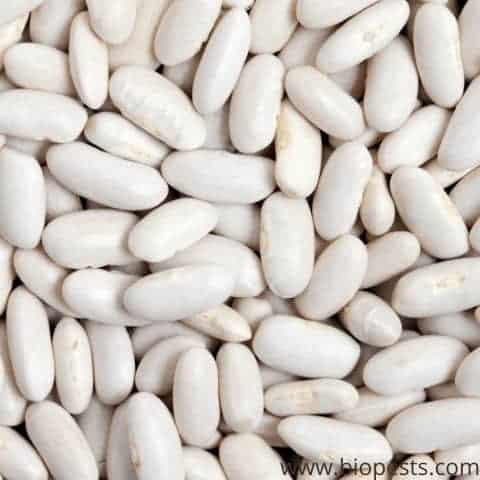
These beans are ideal for use in stew, casseroles, and soups as they keep their form and do not get mushy when cooked for long periods of time. Often used to bulk up dishes, they taste awesome when mashed and added to homemade bread recipes. They have a neutral flavor that compliments dishes that are both sweet and savory.
- The seeds should be planted directly into the soil one week before the last frost.
- They do grow well in colder temperatures and can withstand fluctuations in the weather.
- The plant requires regular watering but beware of overwatering and root rot.
- The great northern bean plant grows tall and spindly with round flat leaves.
- These beans take between 65 and 90 days to mature.
- As a bush plant, it will grow well in a container or in the ground.
3. Lima Beans (Bush And Pole)
Commonly known as butter beans, Lima beans must be eaten when cooked as they are toxic to humans when raw. Canned beans can safely be eaten directly from the can. Smaller varieties are quicker to mature than larger varieties.
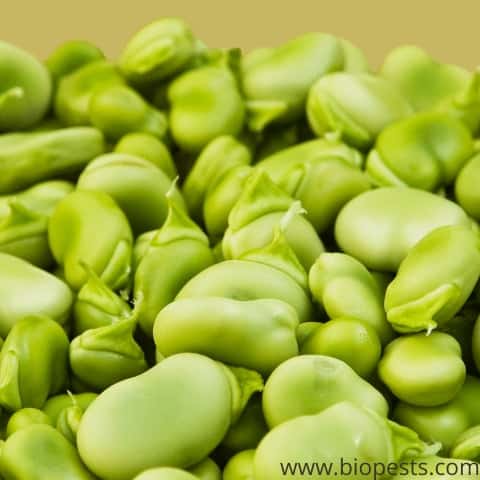
The immature beans are green in color, but when fully grown, they can be black, orange, red, or even mottled colors, although the common color is white.
- An annual plant, they prefer full sun and well-drained soil.
- Plant the seeds after the frost.
- The plant produces white or yellow clusters of flowers.
- Bush varieties can grow 2 to 3 feet tall.
- Pole varieties can grow to 10 feet or more with support.
- Both varieties produce a small crop for harvesting.
- Harvest the crop between 60 and 90 days once the pods feel full.
- The lima bean plant will grow well as a bush plant or a pole plant.
- Plant directly into the soil in the ground or into a container.
4. Navy Beans (Bush And Pole)
Navy beans, so-called because this bean was served to soldiers in the US Navy, are a small dry white bean about the same size as a pea. Also called the haricot bean, navy beans are used in a variety of dishes like baked beans, soups, and pies.
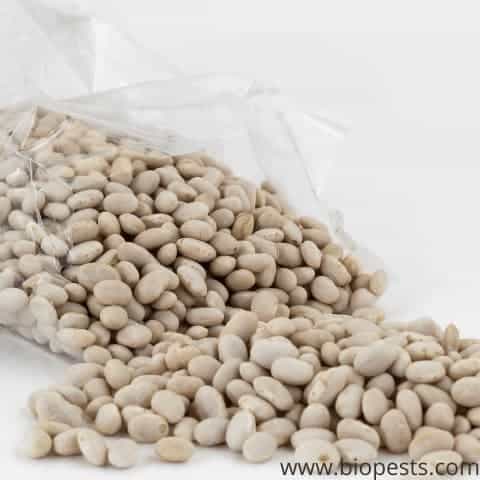
Dried beans should be rinsed before they are used in any dishes and ideally soaked overnight. Canned beans can be used directly from the can in any dish.
- Plant the seeds after the last frost into the ground.
- They will grow well in fertile soil and full sun.
- The pole plant grows to about 2 feet tall and produces seed pods containing 5 or 6 seeds each.
- The bean pods take up to 100 days to mature.
- The beans are ready for harvest when green if they are to be used like green beans, or they can be left to dry out on the plant.
- This bean plant will grow well in containers or directly planted into the ground.
5. Pinto Beans (Pole)
A Mexican bean, the pinto, is often eaten whole in a broth or mashed and refried. The pinto bean is a common filling for Mexican burritos and a staple ingredient in chili.
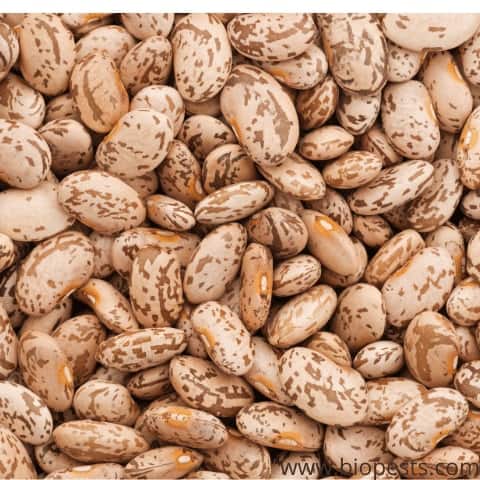
Pinto beans are soaked to shorten the cooking time or boiled rapidly for 10 minutes and then cooked for two to three hours to soften.
A spotted bean, most are tan or cream in color with splashes of reddish-brown when freshly picked, but once cooked, the color changes to either pink or brown.
- Plant the bean seeds directly into the soil in the spring after the frost.
- Pinto beans require six hours of direct sunlight and 1 inch of water per week.
- The bean plant is ready to harvest when the pods are yellow, generally around 150 days.
- They can be harvested after 150 days as a dry bean but can be eaten as a snap bean.
- Suitable for smaller gardens as they don’t need a lot of space.
6. Kidney Beans (Bush And Pole)
Kidney beans are so-called because of their resemblance to a human kidney! There are different types of kidney beans: red, light speckled, red speckled, and white. Cooked kidney beans are often used in chili and soup dishes. They are also used to make stews and pastes.
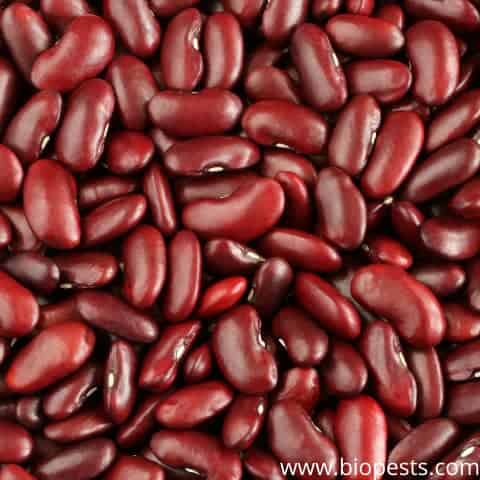
Red kidney beans are significantly more toxic than other bean varieties and must be boiled for at least 30 minutes before being added to a dish. Canned red kidney beans are safe to use directly from the can.
They are easy to grow if their roots do not get waterlogged or damaged. Kidney beans must be grown from seed as they will not survive the transplanting process.
- High in fiber, they can take up to 150 days to mature.
- They need at least 6 hours of direct sunlight per day.
- Plant the seeds only after the last frost of the season.
- Harvest all the bush beans at the end of the season.
- Harvest the pole beans regularly for two months.
- Beans are best dried out and stored in a dark spot for later use.
- A great bean for container planting, although you will need a few plants per pot for a good harvest.
7. Green Beans (Bush And Pole)
Green beans are both bush and pole varieties of beans as they will either grow low on the ground or as a vine. Although they are mostly green, some green bean varieties can be red, yellow, purple, and streaked. They are a stringless bean.
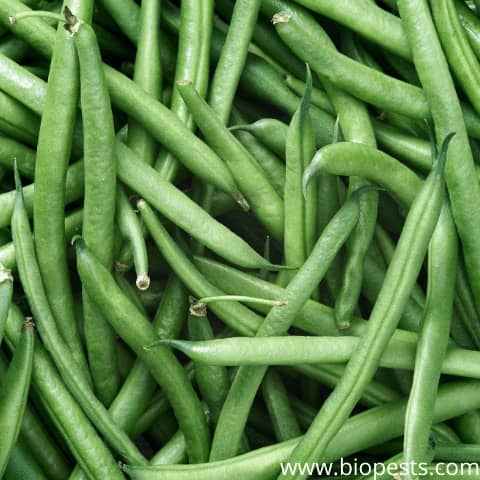
Other names for the green beans are french beans, string beans, or snap beans. The bean pods are eaten with the immature beans inside the pods. They can be eaten raw, steamed, baked, stir-fried, or boiled and are used in dishes like soups, casseroles, and stewed.
- Each bean pod is several inches long and round or flat in shape.
- They are an annual vegetable and should be planted in full sun during spring, after the last frost of the season.
- Bush varieties grow to 2 feet (61cm) in height.
- Pole varieties need to be supported by a trellis or a pole.
- Green beans are generally ready to pick around 50 to 55 days after planting and can be harvested as immature or dry plants.
- The more beans you harvest, the quicker more will grow back on the plant.
- Green bean plants should ideally be planted in the ground as they require space to ramble.
8. Porch Pick Beans (Bush)
A bush bean variety, this bean plant is perfect for growing in containers. Small-leaved plants and crisp green pods loaded with beans.
These beans can be used in any traditional bean dish, eaten freshly picked from the plant, or dried and saved for later use.
- Place container in direct sunlight, only plant the seeds after the last frost of the season.
- The porch bean plant grows to a height of around 18 inches.
- Reaches full maturity at 55 days.
9. Royal Burgundy Beans (Bush)
The royal burgundy bean is a violet pod with green leaves. The pods change from purple to green when cooking. Great for eating when the beans are fresh or for canning and freezing. Store in the refrigerator when fresh for a week.
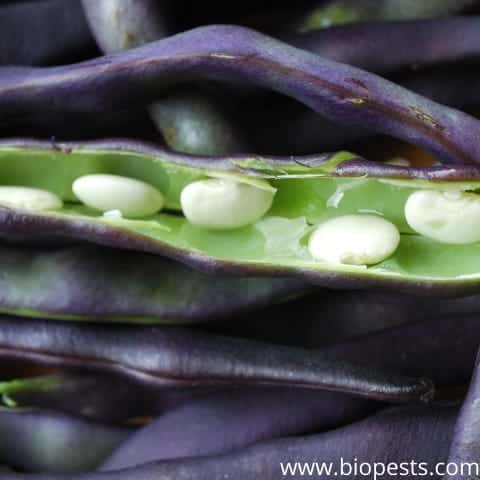
- Plant in a sunny location behind other vegetable crops
- Water the bean plants in the early morning to prevent prolonged wetness of the leaves.
- Each plant grows to a height of 18 inches.
- Beans are ready to harvest from about 75 days after planting.
- After picking the ripe pods, new growth will continue until the end of the growing season.
- A great bean plant to grow in a container.
How To Plant And Grow Beans
Beans are extremely easy to grow. Most bean plants as best planted after the last frost of the season in your area and are generally ready to be harvested about 60 to 100 days after planting.
Follow the below basic steps before planting your beans:
- Prepare the soil for planting. Whether planting in a pot or directly into the soil, seeds require soil with good drainage and nutrients.
- Prepare the trellis for pole beans over the planting area.
- Pole bean seeds should be planted one to a hole at least 3 inches (7.6cm) away from the next seed, 1 inch deep (5.1cm). Pole beans grow vertically.
- Bush bean seeds should be planted one to a hole at least 2 inches (5.1cm) away from the next seed, 1 inch deep (1cm). Bush beans need more space as they grow along the ground.
- Water the seeds immediately after planting. Water every 2 – 3 days to keep the soil moist.
- After the seeds sprout and are 2 inches tall, put down a layer of mulch over the topsoil, 1 inch thick to trap in moisture and block out weeds.
- Add a bean fertilizer to the soil every four weeks to increase the growth of the beans.
- Harvest the beans when ready. Be careful not to tear the plants as this will prevent them from producing new pods.
Conclusion
Before deciding on the type and variety of beans that you would like to plant, make sure that you have the right amount of space available for each variety.
Growing bean plants in your backyard or in a container add wonderful color to your garden, as well as producing a bountiful harvest of beans to eat throughout the growing season and throughout the rest of the year if stored correctly.
Beans can be used as companion plants in your garden as they can replenish vital nutrients which are stripped from the soil by other plants, making the bean plant a must-have in your garden!
Some of the links above are affiliate links, meaning at no additional cost to you, I will earn a commission if you click through and make a purchase.

